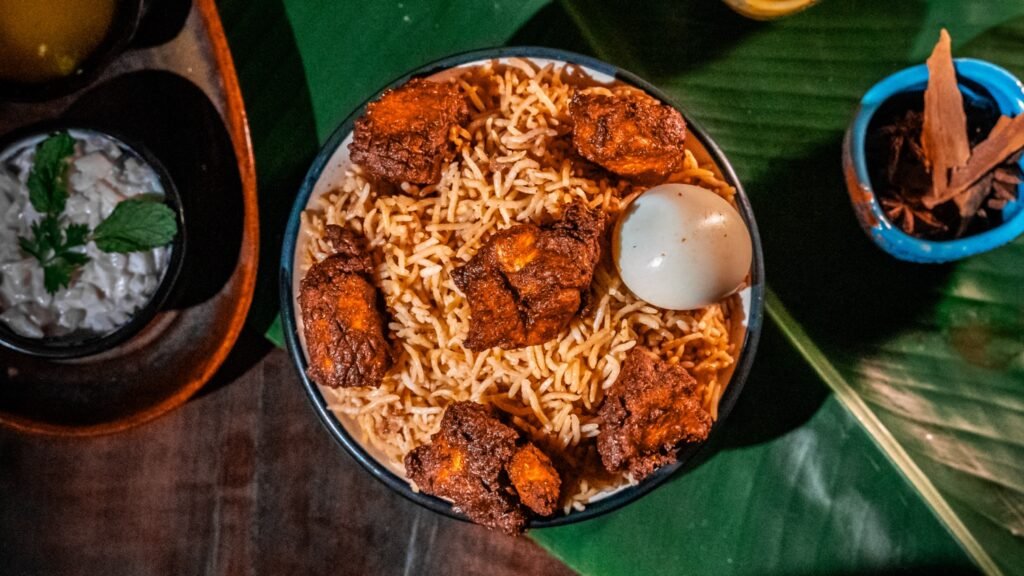The Evolution of Biryani From Traditional Kitchens to Cloud Kitchens

Biryani, a dish that has captured millions’ hearts and taste buds, has a rich history spanning centuries. From its humble beginnings in traditional kitchens to its modern-day popularity in cloud kitchens, biryani has undergone a fascinating evolution. As the world of food delivery changes with the rise of cloud kitchens, it’s essential to understand how biryani has adapted to this new culinary landscape. This blog explores the journey of biryani, highlighting its origins, regional variations, and how it has seamlessly transitioned into the digital age.
The Origins of Biryani
Historical Background
Biryani’s roots trace back to the Indian subcontinent, heavily influenced by Persian and Mughal cuisines. It was initially a royal dish served to kings and emperors, and over time, it became a beloved part of Indian culinary tradition, deeply ingrained in the region’s cultural fabric. The word “biryani” itself is derived from the Persian word “brian,” meaning “fried before cooking,” which hints at the cooking method used in the dish’s preparation.
Traditional Ingredients and Cooking Methods
Traditional biryani is known for its rich, aromatic flavours, achieved through carefully selected ingredients like basmati rice, meat (usually chicken, mutton, or beef), and a blend of spices. The dish is often cooked using the Dum Pukht method, where the ingredients are slow-cooked in a sealed pot, permitting the flavours to meld together beautifully. This method gives biryani its characteristic depth of flavour and tender texture.
Biryani Across Regions: A Culinary Journey
Variations of Biryani in India
India’s diverse culture has given rise to numerous regional variations of biryani, each with its unique twist on the classic dish. For example, Hyderabadi biryani is known for its spicy and tangy flavour, often cooked with marinated meat and saffron. On the other hand, Kolkata biryani is milder and features potatoes alongside the meat. Malabar biryani from Kerala is distinguished by the use of short-grain rice and a mix of ghee and coconut oil, giving it a distinct flavour. Lucknowi biryani, also known as Awadhi biryani, is known for its subtle spices and aromatic saffron, cooked in the Dum Pukht style.
Biryani Beyond Borders
Biryani’s popularity is more comprehensive than that of India. It has spread to neighbouring countries like Pakistan, Bangladesh, and even the Middle East, with each region adding its local flavours. For instance, Pakistani biryani is spicier and often includes yoghurt, while the Middle Eastern versions, such as Persian biryani, might consist of dried fruits and nuts for added richness.
The Rise of Cloud Kitchens
What Are Cloud Kitchens?
Cloud kitchens, also known as dark kitchens, are a modern solution to the growing demand for food delivery. These kitchens operate without a traditional dine-in setup, focusing solely on preparing food for delivery or takeout. The concept has acquired immense popularity due to its efficiency and the ability to reach a broad customer base. It offers the convenience of enjoying your favourite biryani without leaving your home.
The Impact of Cloud Kitchens on Traditional Dining
Cloud kitchens have revolutionised the food industry by presenting flexibility and scalability. For biryani lovers, this means access to their favourite dish from various regional styles, delivered right to their doorstep. The efficiency of cloud kitchens allows for faster preparation and delivery times, making it easier for customers to enjoy freshly made biryani without leaving their homes.
Biryani in the Digital Age
The Transition from Traditional Kitchens to Cloud Kitchens
As biryani transitioned from traditional kitchens to cloud kitchens, it retained its essence while embracing modern cooking techniques. The key to success for cloud kitchen biryani lies in maintaining the authenticity of flavours and the quality of ingredients. Technology plays a vital role in providing consistency, with standardised recipes and precise cooking methods that replicate the traditional taste of biryani.
Popular Cloud Kitchen Brand Serving Biryani
Several cloud kitchen brands have emerged as leaders in serving authentic biryani. Brands like Infinity Biryani Studio have successfully captured the market by offering a range of biryani options, each staying true to its regional roots. These brands have innovated in packaging, ensuring that the biryani reaches customers hot and fresh, preserving the flavours that make it so beloved.
Challenges and Opportunities in Modern Biryani Making
Maintaining Authenticity
One of the primary challenges cloud kitchens face is maintaining the traditional taste and quality of biryani. With the need for quick and convenient food, authenticity can be compromised. However, successful cloud kitchens focus on sourcing quality ingredients and using traditional cooking techniques, even in a modern setting. They also invest in training their chefs to ensure that the essence of biryani is preserved when transitioning to a cloud kitchen environment.
Innovations in Biryani
Cloud kitchens have also introduced creative twists to traditional biryani, catering to evolving consumer preferences. Health-conscious consumers can now enjoy biryani with less oil or opt for vegetarian and vegan versions. Some cloud kitchens even offer fusion biryanis, blending traditional flavours with modern culinary trends, such as quinoa or biryani bowls.
The Future of Biryani in Cloud Kitchens
Predicted Trends
The future of biryani in cloud kitchens looks promising, with several trends set to shape its evolution. As cloud kitchens continue to grow, we can expect to see more regional variations of biryani being offered to cater to diverse palates. Additionally, technology will play an even more significant role, with AI and automation streamlining the cooking and delivery processes. We might also see the rise of more health-conscious biryani options catering to consumers’ evolving dietary preferences.
The Role of Customer Preferences
Customer preferences will continue to drive innovation in biryani offerings. As more people seek convenient and customisable options, cloud kitchens must adapt by offering personalised biryani choices, such as spice levels, protein options, and portion sizes. Social media and online reviews will also play a crucial role in shaping consumer or customer choices and influencing the types of biryani that gain popularity.
Final Words
From its origins in royal kitchens to its modern-day availability through cloud kitchens, biryani has evolved while retaining its rich flavours and cultural significance. The rise of cloud kitchens has made it possible for people to enjoy this beloved dish with the convenience of home delivery without sacrificing authenticity. Infinity Biryani Studio is a prime example of how traditional biryani can thrive in a modern cloud kitchen environment, offering a taste of authentic South Indian and Tamil-style biryani at your doorstep.
Frequently Asked Questions
1. What is a cloud kitchen, and how does it differ from a traditional restaurant?
Unlike traditional restaurants serving on-site food, a cloud kitchen focuses solely on food delivery or takeout without a dine-in option.
2. How do cloud kitchens maintain the quality of biryani?
Cloud kitchens use standardised recipes, high-quality ingredients, and precise cooking methods to ensure consistent taste and quality.
3. Are there healthy options for biryani available in cloud kitchens?
Many cloud kitchens offer healthier biryani options, including versions with less oil and vegetarian and vegan options.
4. What are some popular cloud kitchen brands for biryani?
Popular cloud kitchen brands serving authentic biryani include Behrouz Biryani, Biryani By Kilo, and Paradise Biryani.
5. How has technology influenced the preparation and delivery of biryani in cloud kitchens?
Technology has improved the efficiency of cooking and delivery processes, ensuring that biryani reaches customers fresh and hot.
Author: Manish Pandey
Website: https://publicmediasolution.com/

